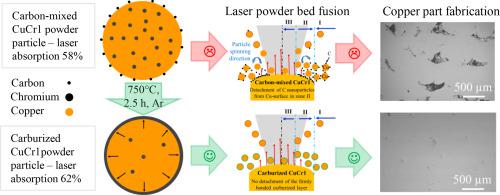当前位置:
X-MOL 学术
›
Mater. Des.
›
论文详情
Our official English website, www.x-mol.net, welcomes your
feedback! (Note: you will need to create a separate account there.)
Laser powder bed fusion additive manufacturing of highly conductive parts made of optically absorptive carburized CuCr1 powder
Materials & Design ( IF 7.6 ) Pub Date : 2021-01-01 , DOI: 10.1016/j.matdes.2020.109369 Suraj Dinkar Jadhav , Pushkar Prakash Dhekne , Etienne Brodu , Brecht Van Hooreweder , Sasan Dadbakhsh , Jean-Pierre Kruth , Jan Van Humbeeck , Kim Vanmeensel
Materials & Design ( IF 7.6 ) Pub Date : 2021-01-01 , DOI: 10.1016/j.matdes.2020.109369 Suraj Dinkar Jadhav , Pushkar Prakash Dhekne , Etienne Brodu , Brecht Van Hooreweder , Sasan Dadbakhsh , Jean-Pierre Kruth , Jan Van Humbeeck , Kim Vanmeensel

|
Abstract Fabrication of fully dense and highly conductive copper alloy parts via laser-based additive manufacturing (L-AM) is challenging due to the high optical reflectivity and high thermal conductivity. To overcome this, the use of optically absorptive surface-modified copper powders is being evaluated in the laser powder bed fusion (LPBF) process. Although the surface-modified powders exhibit high optical absorption at room temperature, not all of them allow the fabrication of fully dense parts at a laser power below 500 W. Accordingly, this article proposes the use of optically absorptive carburized CuCr1 powder for the consistent fabrication of copper parts. Moreover, a densification mechanism of parts is discussed to explain the distinct LPBF processing behavior of different surface-modified powders, such as carburized CuCr1 and carbon mixed CuCr1 powders, albeit having similar room temperature optical absorption. This investigation clearly outlines the advantage of a firmly bonded modified layer present on the surface of the carburized CuCr1 powder over a loosely attached carbon nanoparticle layer present in the carbon-mixed CuCr1 powder. Apart from the successful fabrication of CuCr1 parts, fabricated parts are subjected to two different post-heat treatments, and it is shown that the final properties can be customized by applying tailored post-heat treatments.
中文翻译:

由光吸收性渗碳 CuCr1 粉末制成的高导电部件的激光粉末床熔融增材制造
摘要 由于高光学反射率和高导热性,通过基于激光的增材制造 (L-AM) 制造完全致密和高导电性的铜合金部件具有挑战性。为了克服这个问题,正在评估在激光粉末床融合 (LPBF) 工艺中使用光学吸收性表面改性铜粉。尽管表面改性粉末在室温下表现出高光吸收,但并非所有粉末都允许在低于 500 W 的激光功率下制造完全致密的零件。因此,本文建议使用光吸收性渗碳 CuCr1 粉末进行一致的制造铜零件。此外,讨论了部件的致密化机制,以解释不同表面改性粉末的不同 LPBF 加工行为,例如渗碳的 CuCr1 和碳混合 CuCr1 粉末,尽管具有相似的室温光吸收。该研究清楚地概述了渗碳 CuCr1 粉末表面上存在的牢固结合的改性层相对于碳混合 CuCr1 粉末中存在的松散附着的碳纳米颗粒层的优势。除了成功制造 CuCr1 零件外,制造的零件还要进行两种不同的后热处理,结果表明可以通过应用量身定制的后热处理来定制最终性能。该研究清楚地概述了渗碳 CuCr1 粉末表面上存在的牢固结合的改性层相对于碳混合 CuCr1 粉末中存在的松散附着的碳纳米颗粒层的优势。除了成功制造 CuCr1 零件外,制造的零件还要进行两种不同的后热处理,结果表明可以通过应用量身定制的后热处理来定制最终性能。该研究清楚地概述了渗碳 CuCr1 粉末表面上存在的牢固结合的改性层相对于碳混合 CuCr1 粉末中存在的松散附着的碳纳米颗粒层的优势。除了成功制造 CuCr1 零件外,制造的零件还要进行两种不同的后热处理,结果表明可以通过应用量身定制的后热处理来定制最终性能。
更新日期:2021-01-01
中文翻译:

由光吸收性渗碳 CuCr1 粉末制成的高导电部件的激光粉末床熔融增材制造
摘要 由于高光学反射率和高导热性,通过基于激光的增材制造 (L-AM) 制造完全致密和高导电性的铜合金部件具有挑战性。为了克服这个问题,正在评估在激光粉末床融合 (LPBF) 工艺中使用光学吸收性表面改性铜粉。尽管表面改性粉末在室温下表现出高光吸收,但并非所有粉末都允许在低于 500 W 的激光功率下制造完全致密的零件。因此,本文建议使用光吸收性渗碳 CuCr1 粉末进行一致的制造铜零件。此外,讨论了部件的致密化机制,以解释不同表面改性粉末的不同 LPBF 加工行为,例如渗碳的 CuCr1 和碳混合 CuCr1 粉末,尽管具有相似的室温光吸收。该研究清楚地概述了渗碳 CuCr1 粉末表面上存在的牢固结合的改性层相对于碳混合 CuCr1 粉末中存在的松散附着的碳纳米颗粒层的优势。除了成功制造 CuCr1 零件外,制造的零件还要进行两种不同的后热处理,结果表明可以通过应用量身定制的后热处理来定制最终性能。该研究清楚地概述了渗碳 CuCr1 粉末表面上存在的牢固结合的改性层相对于碳混合 CuCr1 粉末中存在的松散附着的碳纳米颗粒层的优势。除了成功制造 CuCr1 零件外,制造的零件还要进行两种不同的后热处理,结果表明可以通过应用量身定制的后热处理来定制最终性能。该研究清楚地概述了渗碳 CuCr1 粉末表面上存在的牢固结合的改性层相对于碳混合 CuCr1 粉末中存在的松散附着的碳纳米颗粒层的优势。除了成功制造 CuCr1 零件外,制造的零件还要进行两种不同的后热处理,结果表明可以通过应用量身定制的后热处理来定制最终性能。











































 京公网安备 11010802027423号
京公网安备 11010802027423号